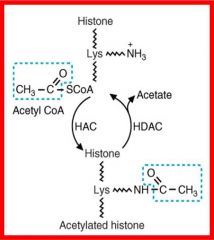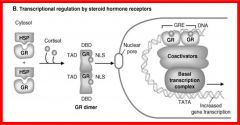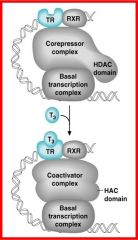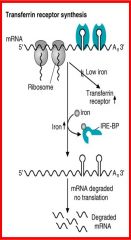![]()
![]()
![]()
Use LEFT and RIGHT arrow keys to navigate between flashcards;
Use UP and DOWN arrow keys to flip the card;
H to show hint;
A reads text to speech;
34 Cards in this Set
- Front
- Back
|
All cells contain (same/different) set of genes
|
same
|
|
|
What are the advantages to regulating gene expression? (4)
|
-cellular control over structure/function
-versatility and adaption -conservation of energy (only need proteins produced - require high energy) -different proteins made during development |
|
|
Transcription is regulated mostly on the level of _____
|
-initiation
|
|
|
The _____ consists of structural genes for proteins with related functions and require one ____
|
-operon
-promoter |
|
|
______ prevent binding of RNA polymerase to the promoter through (positive/negative) control
|
-repressor
-negative |
|
|
Repressors may be a constitutively active repressor, but some other repressors may require a _____ before become active
|
corepressor
|
|
|
Increased Trp inhibits transcription of Trp operson, so Trp acts as a _____ of Trp operson
|
corepressor
|
|
|
_____ stimulate transcription
What do these do? |
-inducers
-bind to promoter repressor and release it from promoter so that RNA polymerase can bind |
|
|
Inducers are usually _____
|
nutrients or their metabolites
|
|
|
Lac operon of E.coli encodes enzymes for _____ and is induced by _____
______ serves as an inducer through binding to the repressor |
-lactose metabolism (to glucose/galactose)
-lactose (no lactose, no need to make enzymes) -lactose metabolite (allolactose) |
|
|
Presence of ______ prevents activation of lac operon
|
glucose
|
|
|
What happens in E coli with the presence of lactose and glucose?
|
-Inducer, allolactose is produced, which inactivates the repressor
-High glucose = low cAMP (cAMP-CRP) is very low = low transcription *cAMP-CRP is a coactivator |
|
|
What happens in E coli with the presence of lactose and absence of glucose?
|
-Inducer, allolactose is produced, which inactivates the repressor
-low glucose = low cAMP, binds to CRP to make cAMP-CRP complex, which binds to operon and stimulates RNA polymerase binding and transcription |
|
|
How does high levels of Trp regulate attenuation of transcription?
Whats the difference if there is low Trp? |
-Ribosomes bind to transcript as it is being transcribed and rapidly translates an mRNA with a hairpin loop, which terminates transcription
-If there is low Trp, ribosomes transcribe the transcript slow, which produces a Trp that does not have a hairpin loop (no hairpin loop = no transcription) |
|
|
Eukaryotes (do/do not) have operons and each gene contains its own ______
|
-do not
-promoter |
|
|
Genes change back and fourth from euchromatin to heterochromatin during:
|
-development
-differentiation |
|
|
What is epigenetic code?
What are two examples of these? |
-changes in chromatin that can be inherited
Angelman syndrome - caused by maternally deleted and paternally imprinted genes on same genetic region Prader-Wills syndrome (PWS) - caused by paternally deleted and maternally imprinted genes on same region |
|
|
What are the two mechanisms for chromatin remodeling?
|

-ATP dependent - unwinds DNA from nucleosome (opens it up) to allow for binding of transcription factors
-Covalent modification of histones (see picture) - Histone acetyltransferase (HAT) aceylates Lys residue on tail of histone, which reduces electrostatic interaction. Histone deacetylases (HDAC) represses chromosome by changing back to amino *Amino group has positive charge which increases interaction of DNA to histone, causing it to be more compact = no transcription |
|
|
Lipophilic hormones regulate transcription through ____
These consists of what domains? (4) |

-nuclear receptors (NRs - Gene specific TFs)
NRs consist of: -Ligand binding domain - ions or molecules -DNA binding domain -Dimerization domain - other hormones -Transactivation domain - binds coactivator |
|
|
_____ on DNA can be methylated to regulate DNA transcription
(hyper/hypo)methylation induces transcription while (hyper/hypo)methylation inhibits methylation Cancer cells show global (hyper/hypo)methylation |
-Cytosine
-Hypomethylation induces -Hypermethylation inhibits -Cancer cells - hypomethylation |
|
|
Methylation of DNA regulates gene expression during _____
|
differentiation (fetal development)
|
|
|
For eukaryotes, transcription is usually regulated at the level of _____
Transcription is regulated by the assembly of _____, which is a complex of _____ and the additional transcription factors that binds to ______, which can increase transcription rate by _____ times and is located ______ |
-initiation
-basal transcription complex -TBP (TATA-binding protein and transcription factors complexed with RNA polymerase II) -gene control regions -up to 1000 times -upstream or downstream |
|
|
Activators, inducers, repressors, or nuclear receptors contain what to regulate transcription?
|
-DNA binding domain
-Domain for mediator proteins (coactivators, corepressors, or TBP-associated factors) -Steroid hormone (can bind either corepressor or coactivator) -Transcription Factors (TFs - can induce or inhibit transcription) |
|
|
How do glucocorticoids activate transcription?
|

-Glucocorticoid receptor (GR) binds to CORTISOL in CYTOSOL
-GR dissociates from HSP, exposing NLS and forms a dimer -dimer translocates into nucleus and binds to glucocorticoid response element (GRE) -Transactivating domain binds to coactivator, initiating transcription |
|
|
How do the heterodimer thyroid hormone (TR) and retinoid X receptor (RXR) regulate transcription?
|

-heterodimer is bound to DNA
-without thyroid hormone, it binds to corepressor and inhibits transcription -with thyroid hormone, hormone binds to TR and causes conformation change and binds to coactivator, causing transcription *HDAC attaches to corepressor (HDAC causes nucleosomes and DNA to be tightly bound) |
|
|
What is androgen insensitivity disease (AIS)?
What happens when a woman has complete AIS? Incomplete AIS can lead to what? (2) |
-patient can produce androgens, but lack its receptors
-normal female body except for 46XY chromosome Can lead to: -Gynecomastia - breast in men -Cryptochidism - one or both testes do not descend from scrotum after birth |
|
|
Transcription factors (TFs) can also regulate level transcription. In what ways do TFs regulate transcription?
|
-levels of TFs
-binding of inhibitor or stimulator -stimulation of nuclear entry -phosphorylation (CREB by PKA or MAP kinase) |
|
|
In splicing or mRNA, (exons/introns) are "junk DNA, and (exons/introns) read to make protein
This results in: The most common type of splicing is |
-introns
-exons -diverse set of proteins from limited genes -exon skipping |
|
|
apoB mRNA is an example of splicing and can be found in:
Intestinal apoB has been found to: apoB _____ are more prone to atherosclerosis and apoB _____, and animals with low or no _____ apoB editing activity have higher levels of ____ |
-liver and intestines
-more efficient fat absorption -apoB100 than apoB48 -no hepatic apoB mRNA editing = high levels of VLDL/LDL |
|
|
Gene expression can also be regulated through mRNA degradation. What are the two ways this happens?
|
-shortening of polyA tail (mRNA turnover) - loss of tail leads to exosome from 3' end
-decapping - degraded from 5' end |
|
|
What does transferrin receptors do and how is it regulated?
|

-Transferrin receptor takes up transferrin which is a iron transporter in blood
-High iron = no need for receptors - iron binds to IRE-BP and releases mRNA and mRNA is degraded -Low iron = want for more receptor - IRE-BP binds to IRE and prevents degradation of mRNA |
|
|
What is ferritin and how is it regulated?
|

-Ferritin is main storage protein of iron
-Low iron = no need for ferritin - Iron does not bind to IRE-BP near 5' end and stays bound to mRNA to prevent translation -High iron = need ferritin - Iron binds to IRE-BP and dissociates from mRNA to initiate translation of ferritin |
|
|
In prokaryotes, regulation of gene expression occurs through:
|
-induction and repression of transcription (repressors, inducers, corepressors, coactivators)
|
|
|
In eukaryotes, regulation of gene expression occurs through:
|
-chromatin modification and remodeling (HAT and HDACs/DNA and histone methyltransferases)
-regulation of transcription initiation (positive and negative transcription factors) -level of translation (mRNA editing/mRNA degradation/binding of ribosome to mRNA) |

